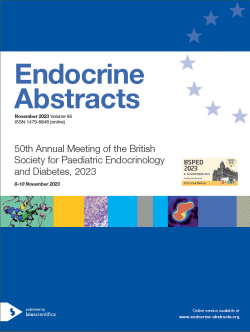
50th Annual Meeting of the British Society for Paediatric Endocrinology and Diabetes
Manchester,
UK
08 Nov 2023 - 10 Nov 2023

Poster Presentations
Gonadal, DSD and Reproduction 2
ea0095p120 | Gonadal, DSD and Reproduction 2 | BSPED2023
Multidisciplinary team management in an andrology service for Klinefelter Syndrome: A review of current practice
Alexopoulou Vasiliki , Bambang Katerina , Senniappan Senthil
ea0095p121 | Gonadal, DSD and Reproduction 2 | BSPED2023
Characterising puberty in children and young people with Alstrom Syndrome
Anwunah Ijeoma , Barrett Tim , Kershaw Melanie
ea0095p122 | Gonadal, DSD and Reproduction 2 | BSPED2023
Characterisation of children and young people (CYP) presenting with differences in sex development (DSD) beyond the neonatal period: A single centre retrospective observational study
Shirodkar Diksha , Baioumi Alaa , Giri Dinesh , Candler Toby , Burren Christine , Hamblin Rachel , Alderson Julie , Crowne Elizabeth
ea0095p123 | Gonadal, DSD and Reproduction 2 | BSPED2023
Testosterone therapy in Duchenne muscular dystrophy and longitudinal bone growth with metacarpophalangeal length measurement
McCauley Cara , Dunne Jennifer , Horrocks Iain , Joseph Shuko , Wong Sze Choong
ea0095p124 | Gonadal, DSD and Reproduction 2 | BSPED2023
The value of the stimulated testosterone: dihydrotestosterone ratio in 46, XY DSD due to 5alpha-reductase type 2 deficiency
Balagamage Chamila , Igbokwe Rebecca , Idkowiak Jan , Mohamed Zainaba
ea0095p125 | Gonadal, DSD and Reproduction 2 | BSPED2023
Audit of the investigations and treatment for adolescents with irregular menstruation/suspected Polycystic Ovarian Syndrome at The Noah’s Ark Children’s Hospital for Wales
Aneva Katrin , Rees Professor Aled , Williams Dr Georgina
ea0095p126 | Gonadal, DSD and Reproduction 2 | BSPED2023
A case of 46, XY differences of sex development (DSD) due to FKBP4 deficiency: A novel candidate of androgen insensitivity syndrome?
Balagamage Chamila , Igbokwe Rebecca , Robinson Hannah , McCarthy Liam , Chandran Harish , Godber Caroline , Mohamed Zainaba , Idkowiak Jan
ea0095p127 | Gonadal, DSD and Reproduction 2 | BSPED2023
Complexities of gender assignment in 17β-hydroxysteroid dehydrogenase type 3 deficiency
Riaz Maira , Yasir Mehrunnisa , Rathor Heeranand , Ibrahim Mohsina
ea0095p128 | Gonadal, DSD and Reproduction 2 | BSPED2023
Challenging clinical scenario: Germ cell tumor masquerading as peripheral precocious puberty in a one-year-old boy from Pakistan
Versha Rani Rai , Mohsina Noor Ibrahim , Sanagar Ali , Maira Riaz , Roshia Parveen , Mehrunnisa Yasir
ea0095p129 | Gonadal, DSD and Reproduction 2 | BSPED2023
Kallmann syndrome: A FGFR1 mutation
Clemente Marisa , Naghmuish Eiman , Weerasinghe Kamal



